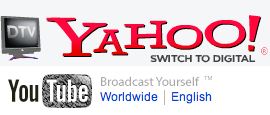 If you’re reading this, chances are you haven’t been using an over-the-air antenna to get analog television service for quite some time. I’m not even sure I’ve seen the “rabbit ears” since the 80s. But just in case you are one of the rumored 6 million Americans who aren’t ready for the switch from analog to digital, Yahoo and YouTube are doing their part to remind you. Both sites feature analog-to-digital logos to mark the transition that happens today.
If you’re reading this, chances are you haven’t been using an over-the-air antenna to get analog television service for quite some time. I’m not even sure I’ve seen the “rabbit ears” since the 80s. But just in case you are one of the rumored 6 million Americans who aren’t ready for the switch from analog to digital, Yahoo and YouTube are doing their part to remind you. Both sites feature analog-to-digital logos to mark the transition that happens today.
While YouTube’s is purely cosmetic, Yahoo was nice enough to link its to a site that gives users more details about the switch. But again, I’m not sure that at this point if you’ve missed the notice after notice that the transition was happening, that’s you’re surfing Yahoo either — or own a computer, or even watch TV. The U.S. government started a $1.2 billion campaign in 2007 to let people know about the switch. But somehow all that time and money still wasn’t enough as Congress had to delay the transition in February (when it was supposed to occur) and give the program more money.
Now that the transition is finally happening, the companies that bid on that spectrum last year can finally start actually using it. The auction of those airwaves by the FCC raised nearly $20 billion, with Verizon taking a large chunk of the coveted C-block. You probably remember hearing about the auction on a lot of tech sites because Google threw down the gauntlet early on and promised to pledge at least $4.6 billion towards a part of the spectrum. It didn’t end up winning any part, but by raising the stakes, Google no doubt helped ensure that the minimum bid was met — because the thought of Google winning a huge chunk of wireless airspace that it could use for a number of things, including mobile communication, likely scared the hell out of the giant telcos.
And Google also pushed hard to make sure that no matter who won the bidding, that the spectrum was “open,” meaning any company’s products and services could be used on it. Products and services like the ones Google provides. While Google of course owns YouTube, it’s own logo doesn’t reflect the transition today. Perhaps it realizes that the vast majority of its users probably haven’t been in danger of being effected by it since the 80s.